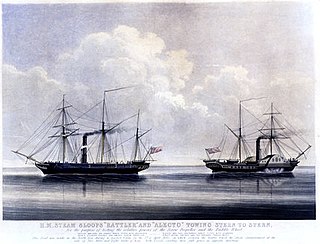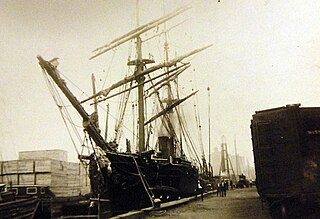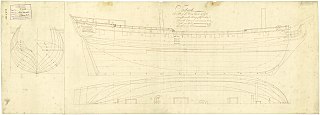The Royal Navy has used the name Comet no fewer than 18 times:

HMS Rattler was a 9-gun steam screw sloop of the Royal Navy, and one of the first British warships to be completed with screw propulsion. She was originally ordered as a paddle wheel 4-gun steam vessel from Sheerness Dockyard on 12 March 1841. She was reordered on 24 February 1842 as a propeller type 9-gun sloop from HM Royal Dockyard, Sheerness, as a new vessel. William Symonds had redesigned the ship as a screw propeller driven vessel.
HMS Scorpion was a 14-gun two-masted Merlin-class sloop of the Royal Navy, built by Wyatt and Major at Bucklers Hard on the Beaulieu River in Hampshire, England and launched on 8 July 1746.

The Cruizer class was an 18-gun class of brig-sloops of the Royal Navy. Brig-sloops were the same as ship-sloops except for their rigging. A ship-sloop was rigged with three masts whereas a brig-sloop was rigged as a brig with only a fore mast and a main mast.
HMS Rover was a 16-gun sloop-of-war that the Royal Navy purchased in 1796, commissioned in 1798, and that was wrecked in early 1798. In her brief career she captured one French privateer.

HMS Frolic was an 18-gun Cruizer-class brig-sloop of the Royal Navy. She was built by Boole, of Bridport and was launched on 9 February 1806. Although she took part in the capture of Martinique, Guadaloupe, and Saint Martin, she appears to have had an uneventful career until 8 October 1812, when the American sloop-of-war USS Wasp captured her after a fierce fight. Later that day the British recaptured Frolic and captured Wasp. Frolic was broken up in 1813.
HMS Hazard was a 14-gun Merlin-class sloop launched in 1744. She was captured in November 1745 by Jacobite forces in Montrose harbour and was sailed to Dunkirk and was renamed Le Prince Charles.

HMS Pelican was an Osprey-class sloop built for the Royal Navy in the mid-1870s. She was launched in 1877 and was sold to the Hudson's Bay Company in 1901. She was scuttled in 1953.

HMS Hind was a 10-gun two-masted Hind-class sloop of the Royal Navy, designed by Joseph Allin and built by Philemon Perry at Blackwall on the Thames River, England and launched on 19 April 1744.

HMS Vulture was a 10-gun two-masted Hind-class sloop of the Royal Navy, designed by Joseph Allin and built by John Greaves at Limehouse on the Thames River, England and launched on 4 May 1744, during the War of the Austrian Succession. Her name was often written as Vulter.
HMS Jamaica was a 10-gun two-masted Hind-class sloop of the Royal Navy, designed by Joseph Allin and built by him at Deptford Dockyard on the Thames River, England and launched on 17 July 1744. She and her sister Trial were the only sloops to be built in the Royal Dockyards between 1733 and 1748.

HMS Trial or Tryall was a 10-gun two-masted Hind-class sloop of the Royal Navy, designed by Joseph Allin and built by him at Deptford Dockyard on the Thames River, England. She was launched on 17 July 1744. She and her sister ship, Jamaica, were the only sloops to be built in the Royal Dockyards between 1733 and 1748.

HMS Saltash was an 8-gun two-masted sloop of the Royal Navy, built on speculation by Henry Bird at Deptford Wet Dock on the Thames River, England. She was purchased while building by the Navy Board at the end of August 1741 to replace the 1732-built sloop of the same name. The new sloop was launched on 3 September.

HMS Wolf was a 14-gun snow-rigged sloop of the Royal Navy, launched in 1742 as the first of three Wolf-class sloops constructed for action against Spanish privateers during the War of Jenkins' Ear.
The Alderney class was a class of three sloops of wooden construction built for the Royal Navy between 1755 and 1757. All three were built by contract with commercial builders to a common design prepared by William Bately, the Surveyor of the Navy.
HMS Weazel or Weazle was a 16-gun ship-sloop of the Royal Navy, in active service during the War of the Austrian Succession, the Seven Years' War and the American Revolutionary War. Launched in 1745, she remained in British service until 1779 and captured a total of 11 enemy vessels. She was also present, but not actively engaged, at the Second Battle of Cape Finisterre in 1747.

Bellone, was a French privateer. Bellone was involved in a naval battle in Loch nan Uamh during the Jacobite rising. She was captured in 1747. She was taken into Royal Navy service as HMS Bellona and was sold in 1749.

HMS Wasp was an Archer type sloop ordered on 25 April 1847 from Deptford Dockyard. Two references stipulate that Parthian, ordered with Archer the year prior was renamed Wasp when ordered as a sloop. However, Parthian remained on the books at Deptford, as a Rifleman type gunvessel until cancelled in June 1849. Therefore Wasp was a new build. She served on many different stations during her career, including West Coast of Africa, in the Mediterranean and Black Sea during the Russian War of 1854 - 55, on the South East Coast of America, Cape of Good Hope where she went aground twice and the East Indies before being sold for breaking in December 1869.

HMS Swallow was a 14-gun Merlin-class sloop of the Royal Navy. Commissioned in 1745, she initially served in home waters as a convoy escort and cruiser before sailing to join the East Indies Station in 1747. There she served in the squadron of Rear-Admiral Edward Boscawen, taking part in an aborted invasion of Mauritius and the Siege of Pondicherry. In 1755 Swallow returned home to join the Downs Station, as part of which she fought at the Raid on St Malo, Raid on Cherbourg, and Battle of Saint Cast in 1758. She was also present when the French fleet broke out of Brest prior to the Battle of Quiberon Bay in 1759.
HMS Squirrel was designed by Richard Stacey, Master Shipwright of Woolwich. Her design was based on the standardize 20-gun sixth rates. After commissioning she was assigned to Home Waters then the Mediterranean. She took a privateer in 1710. She was dismantled at Deptford with her timbers sent to Woolwich Dockyard for rebuilding as a 374-ton (bm). She was finally broken in 1749.










